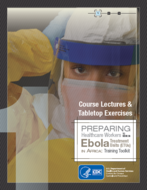
CDC recently released a comprehensive training toolkit, Preparing Healthcare Workers to Work in Ebola Treatment Units (ETUs) in Africa. The toolkit is designed to help organizations replicate CDC’s 3-day in-person training course that prepared healthcare workers (HCWs) to work safely in ETUs in Africa. The comprehensive toolkit includes lectures, exercise scenarios, templates, and videos that teach the principles of infection prevention and control in African ETUs.
Preparing Healthcare Workers to Work in Ebola Treatment Units (ETUs) in Africa: Training Toolkit Announcement
Page Summary
Purpose: The training toolkit is designed to help organizations replicate CDC’s 3-day in-person training course to help prepare healthcare workers (HCWs) to work in ETUs in Africa.
Intended audience: Organizations that want to offer a training course for HCWs preparing to work in ETUs in Africa in response to the Ebola epidemic.
Ebola Training Toolkit Overview Webinar
Originally aired March 19, 2015, 12 noon - 12:35 p.m. Eastern.
CDC hosted a webinar March 19, 2015, to provide an overview of the new Ebola Training Toolkit, Preparing Healthcare Workers to Work in Ebola Treatment Units (ETUs) in Africa. The toolkit is designed for organizations that want to offer a training course for healthcare workers (HCWs) preparing to work in ETUs in Africa in response to the Ebola epidemic. The webinar included information about the toolkit components and a Question and Answer segment.
The CDC training toolkit contains information from similar courses developed by Médecins Sans Frontières (MSF) and the World Health Organization (WHO), and on CDC guidelines for infection prevention and control.
The toolkit is a complete guide with training materials, templates, and videos to help offer a course that:
- Teaches HCWs principles of infection prevention and control to work safely in an ETU setting
- Uses blended learning methods, including:
- Lectures focused on Ebola transmission, epidemiology, and infection prevention and control
- Tabletop exercises providing opportunities for students to discuss lecture content and how to apply it in ETUs
- Hands-on interactive exercises in a mock ETU where students:
- Apply the concepts they learned in the lectures and discussed in tabletop exercises
- Practice donning and doffing personal protective equipment (PPE)
- Perform simulated patient care activities while wearing PPE
The training course is considered a first step in preparing HCWs to work in an ETU. When they deploy to work in real ETUs, HCWs are expected to receive additional training and mentoring before they begin working independently.






















.png)











No hay comentarios:
Publicar un comentario